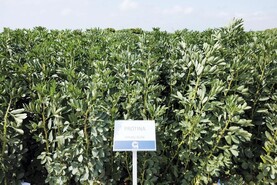Some spring bean crops are now flowering. Early-sown crops have been flowering for a while and may be reaching their second fungicide.
The majority of crops sown in late April are only starting to flower or will start to flower in the coming days.
These crops will need to be treated with a fungicide.
Chocolate spot and brown rust are the main diseases of concern and downy mildew. However, downy mildew is very harder to control.
Signum contains boscalid and pyraclostrobin. It offers good control of brown rust and moderate control of chocolate spot. Its maximum dose on a crop is 1kg/ha and a maximum of two applications can be used on a crop.
Elatus Era can be applied at 0.66l/ha and can only be applied once. It also works to control chocolate spot and rust. It contains prothioconazole and an SDHI.
Two sprays
Foliar phosphorus and potassium are sometimes applied to try to keep away downy mildew.
Many people usually apply two fungicide sprays to bean crops. Early-sown crops will certainly benefit from this.
Given the later sowing date of some crops this year, consider the benefit of a second fungicide spray on those crops. You want to keep plants green and producing yield, but you also want to be able to harvest the crop relatively early. More fungicide is likely to keep the crop greener for longer.
However, there could be high disease pressure which will require another fungicide. It is up to each individual farmer to decide. Consider field history, disease levels and yield potential when deciding whether or not to apply a second fungicide to the crop.
Grass weeds
If using a product like Falcon to control grass weeds in beans this needs to be applied before flowering starts on the plant. Stratos Ultra can be used when flowering has started.
Controlling grass weeds in beans is a good opportunity to use different chemistry than in a cereal crop and to try to reduce the risk of resistance build-up to herbicides.






 This is a subscriber-only article
This is a subscriber-only article










SHARING OPTIONS: